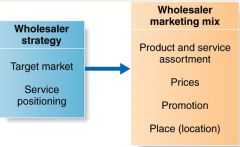![]()
![]()
![]()
Use LEFT and RIGHT arrow keys to navigate between flashcards;
Use UP and DOWN arrow keys to flip the card;
H to show hint;
A reads text to speech;
20 Cards in this Set
- Front
- Back
|
definition of retailing |
all activities involved in selling goods and/or services directly to final consumers for personal nonbusiness use |
|
|
examples of nonstore retailing |
direct mail, catalogs, telephone, home and office parties, home shopping shows, internet |
|
|
definition of a retailer |
business whose sales come primarily from retailing; can be brick and mortar, 100% virtual, or click and mortar |
|
|
types of retailers |
superstores, specialty stores, department stores, supermarkets, discount stores, convenience stores and off-price retailers |
|
|
how are retailers classified by? |
amount of service, product lines, relative prices and organizational approach |
|
|
amount of service provided by retailers |
self service retailers, limited service (most department stores), full service (high end department, specialty stores) |
|
|
how to classify retailers via product lines |
specialty stores: narrow product lines with deep assortments department stores: wide variety of product lines supermarkets convenience stores: limited line superstores: sell food, nonfood, services category killers: IKEA, Tampines Courts; giant specialty stores |
|
|
relative prices of retailers |
discount stores: low margins offset by high volume off-price retailers: - independent off-price retailers: parisilk electronics, song & song - factory outlets: levi strauss, IMM stores - warehouse clubs: sam's club, costco, sungei kadut (might not work based on demographics) |
|
|
the organizational approach for retailers |
corporate chain stores: commonly own/controlled e.g. metro singapore, OG, H&M voluntary chains: wholesaler-sponsored groups of independent retailers retailer cooperatives: groups of independent retailers who buy in bulk e.g. associated grocers franchise organizations: based on uniqueness e.g. 7/11, MacDonalds merchandising conglomerates: diversified retailing lines under central ownership |
|
|
retailer marketing mix decisions |

|
|
|
what consists of the retailer marketing mix |
price: high markup or high volume promotion: public relations, sales promotions, advertising, direct marketing place: location!! |
|
|
the future of retailing |
new retail forms and shortening retail life cycles: wheel-of-retailing concept; retailers start small, increase prices as they grow growth of nonstore retailing: mail-order, tele, phone, online shopping, vending machines retail convergence |
|
|
the future of retailing |
rise of mega retailers growing importance of retail technology global expansion of major retailers retail stores as "communities" or "hangouts" |
|
|
definition of wholesaling |
all activities involved in selling goods and services to those buying for resale or business use |
|
|
definition of wholesaler |
a firm engaged primarily in wholesaling activity |
|
|
how do wholesalers add value |
selling and promoting buying and assortment building bulk-breaking warehousing transportation financing risk bearing marketing info management services and advice |
|
|
wholesaler marketing mix decisions |

|
|
|
how to make targeting decisions |
size of customer, type of retailer, need for service |
|
|
wholesaler marketing mix decisions |
product and service assortment: inventory, product line pricing: usual markup on COG is 20% promotion: largely disorganized and unplanned place: location, facilities |
|
|
trends in wholesaling |
price competition is still intense successful wholesalers must add value by increasing efficiency and effectiveness distinction between large retailers and wholesalers continues to blur more services provided to retailers going global |

